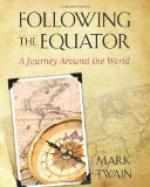“South Africa As It Is,” by Mr. Statham, an able writer partial to the Boers; “The Story of an African Crisis,” by Mr. Garrett, a brilliant writer partial to Rhodes; and “A Woman’s Part in a Revolution,” by Mrs. John Hays Hammond, a vigorous and vivid diarist, partial to the Reformers. By liquifying the evidence of the prejudiced books and of the prejudiced parliamentary witnesses and stirring the whole together and pouring it into my own (prejudiced) moulds, I have got at the truth of that puzzling South African situation, which is this:
1. The capitalists and other chief men of Johannesburg were fretting under various political and financial burdens imposed by the State (the South African Republic, sometimes called “the Transvaal”) and desired to procure by peaceful means a modification of the laws.
2. Mr. Cecil Rhodes, Premier of the British Cape Colony, millionaire, creator and managing director of the territorially-immense and financially unproductive South Africa Company; projector of vast schemes for the unification and consolidation of all the South African States, one imposing commonwealth or empire under the shadow and general protection of the British flag, thought he saw an opportunity to make profitable use of the Uitlander discontent above mentioned—make the Johannesburg cat help pull out one of his consolidation chestnuts for him. With this view he set himself the task of warming the lawful and legitimate petitions and supplications of the Uitlanders into seditious talk, and their frettings into threatenings—the final outcome to be revolt and armed rebellion. If he could bring about a bloody collision between those people and the Boer government, Great Britain would have to interfere; her interference would be resisted by the Boers; she would chastise them and add the Transvaal to her South African possessions. It was not a foolish idea, but a rational and practical one.
After a couple of years of judicious plotting, Mr. Rhodes had his reward; the revolutionary kettle was briskly boiling in Johannesburg, and the Uitlander leaders were backing their appeals to the government—now hardened into demands—by threats of force and bloodshed. By the middle of December, 1895, the explosion seemed imminent. Mr. Rhodes was diligently helping, from his distant post in Cape Town. He was helping to procure arms for Johannesburg; he was also arranging to have Jameson break over the border and come to Johannesburg with 600 mounted men at his back. Jameson—as per instructions from Rhodes, perhaps—wanted a letter from the Reformers requesting him to come to their aid. It was a good idea. It would throw a considerable share of the responsibility of his invasion upon the Reformers. He got the letter—that famous one urging him to fly to the rescue of the women and children. He got it two months before he flew. The Reformers seem to have thought it over and concluded that they had not done wisely; for the next day after giving Jameson the implicating document they wanted to withdraw it and leave the women and children in danger; but they were told that it was too late. The original had gone to Mr. Rhodes at the Cape. Jameson had kept a copy, though.




